Just Transition Commission: background report
Background information report on the Scottish economy to help inform the early deliberations of the Just Transition Commission.
2. Population
Summary of Evidence: Population
The population of Scotland has increased each year since 2001 and it is now at its highest level ever at 5.42 million.
Over the past decade Scotland's population has increased by 5%. International migration has been the largest contributor to Scotland's population growth over the past ten years, and to a greater extent than in any other part of the UK.
From 2007-08 to 2013-14 there were more births than deaths in Scotland. However, there have been more deaths than births since 2014-15 and is projected to be the case for every year going forward to 2041. Future population growth will rely on net inward migration.
Although the gender balance is broadly even, the growth in over 75 age group is predominately male (an increase of 94% between 2016 and 2041 compared to 64% for females).
Although three-quarters of Local Authority areas will increase their population, only six will grow at above the national average.
Migration patterns will impact differentially on cities and other areas, with the central belt and other cities benefitting from net migration while other mostly rural or places with fewer job opportunities suffer population declines.
In 2015-16, net migration to Scotland was positive at 31,700, with 22,900 from overseas and 8,800 from the rest of the UK.
Net migration to Scotland from the rest of the UK is projected to remain at current levels but with both in and out migration increasing. However, migration from overseas is projected to decrease substantially from 40,400 in 2015-16 to 30,500 in 2040-41, while out-migration to overseas is projected to increase from 17,500 to 23,500 over the same period.
Scotland's population is ageing. This is not a new phenomenon but it is set to accelerate from 2021 onwards and is happening at a faster rate than in the rest of the UK. The dependency ratio will increase from 0.55 in 2016 to 0.70 in 2041.
The population of Scotland is projected to rise from 5.40 million in 2016 to 5.58 million in 2026, and to continue to rise to 5.69 million in 2041 – an increase of 5% over the 25-year period.
The working age population is projected to increase from 3.43 million in 2016 to a peak of 3.59 million in 2028 (an increase of 5%). It is then projected to decline to 3.47 million by 2041. Overall there is a 1% projected increase in people of working age over the 25-year period.
Most areas are projected to see an increase in their working age population, with 21 of 32 council areas in this category. However, parts of the west of Scotland and Scotland's island councils are projected to have smaller working age populations in 10 years' time.
The evidence base
Population growth
2.1. The population of Scotland has increased each year since 2001 and it is now at its highest level ever at 5.42 million. Over the past decade population has grown by 5% but more recently the rate has slowed due to lower migration levels, decrease in fertility and increase in mortality.
2.2. The Scottish Government has set a target to match average European (EU15) population growth over the period 2007 to 2017, supported by increased healthy life expectancy in Scotland over this period. For the latest year, population growth for Scotland has been higher than that of the EU 15 countries. It was outlined in the Government Economic Strategy (GES)[1] that population growth is a key contributor to, and consequence of, a growing and diversified economy.
2.3. The population of Scotland is projected to rise from 5.40 million in 2016 to 5.58 million in 2026, and to continue to rise to 5.69 million in 2041 – an increase of 5% over the 25-year period[2]
2.4. There are projected to be more deaths than births in every year going forward. Each year for the next twenty-five years all of Scotland's population growth is projected to come from migration[3] (figure 2.2).
Figure 2.1: Actual and projected natural change and net migration in Scotland (000s)[4]
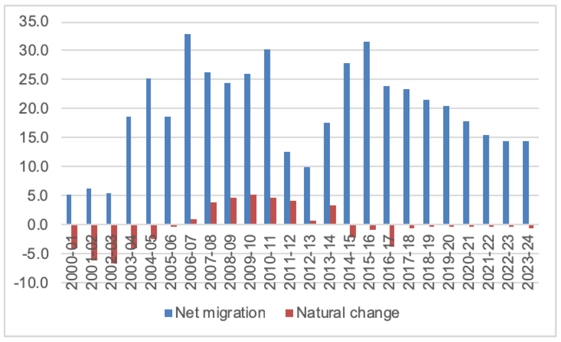
Source: Mid-year population estimates and National Population Projections (2016-based), National Records of Scotland
2.5. Scotland's population growth over the next ten years is projected to be predominantly in the central belt and urban areas, and mostly as a result of migration patterns.
2.6. Three quarters of local authority areas (24 councils) are expected to see growth. However, only six local authority areas will benefit from above average growth – Midlothian (13.3%); East Lothian (8.6%); City of Edinburgh (7.7%); East Renfrewshire (7.6%); Aberdeenshire (7.1%); and West Lothian (6.6%)[5].
2.7. Areas facing depopulation comprise Na H-Eileanan Siar (-4.8%); Inverclyde (-3.8%); Argyll and Bute (-3.4%); North Ayrshire (-2.1%); Dumfries and Galloway (-1.5%); South Ayrshire (-0.9%); West Dunbartonshire (-0.7%); and East Ayrshire (-0.2%)10
Demographic change
2.8. Scotland's population is ageing. The Scottish Government's Fiscal Outlook states that while an ageing population is not new, it "is set to accelerate from 2021 onwards and is happening at a faster rate than in the rest of the UK." Figure 2.2 presents the projected changes in population by age group as an index which highlights the rate of change expected on the 2016 base year:
- There is a significant increase in the over 75 age group
- Those aged 65 to 74 are the only other group to increase in size
- Together, the over 65s account for 153% of the projected population increase
- All younger age groups are expected to decline in size
- Scotland's dependency ratio[6] increases from 0.55 in 2016 to 0.70 in 2041.
Figure 2.2: Population estimates by age expressed as an index (2016=100)
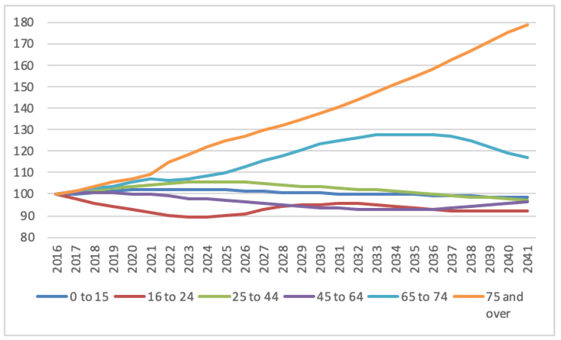
Source: Mid-year population estimates and National Population Projections (2016-based), National Records of Scotland
2.9. Although the gender balance is broadly even, the growth in over 75 age group is predominately male (an increase of 94% between 2016 and 2041 compared to 64% for females). Improved health is a major factor here.
Figure 2.3: Forecast Scottish total population and population aged 16 to 64, thousands
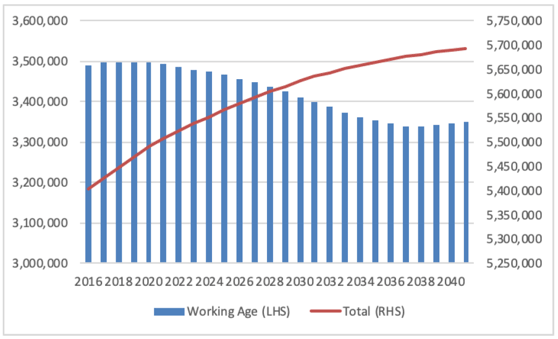
Source: Mid-year population estimates and National Population Projections (2016-based), National Records of Scotland
Migration
2.10. The Fiscal Outlook[7] states that international migration "has been the largest contributor to Scotland's population growth over the past ten years, and to a greater extent than in any other part of the UK" and the "most recent population projections from National Records of Scotland indicate that all of Scotland's population growth over the next 25 years is expected to come from migration (from both overseas and the rest of the UK)
2.11. The Scottish Government recently published a paper on Scotland's population needs and migration policy[8]. "Economic models show that a decrease in labour supply as a result of lower levels of migration has a substantial negative impact on both the Scottish and the UK economy".
2.12. Between 2016 and 2041, the population of pensionable age is projected to rise from 1.05 million to 1.32 million, an increase of 25%, while the number of children is projected to decrease from 0.92 million to 0.90 million (reduction of 2%) over the same period. The number of people aged 75 and over is projected to increase by 27% over the next ten years and increase by 79% over the next 25 years to 204110 (Figure 2.3).
Figure 2.4: Age profile of Scottish population in 2016 and 2041[9]
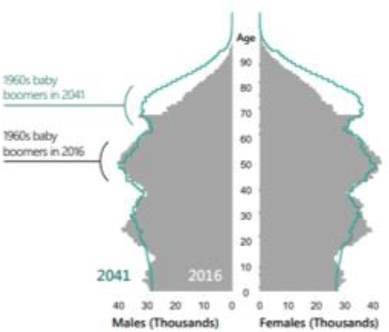
Source: Mid-year population estimates and National Population Projections (2016-based), National Records of Scotland, Office for National Statistics
2.13. Between 2016 and 2026, all council areas in Scotland are projected to experience an increase in their population aged 75 and over. Clackmannanshire (+48%) and West Lothian (+46%) are projected to experience the largest increases, while Dundee City (+9.6%) and Glasgow City (+2.9%) have the smallest increases.
2.14. The working age population is projected to increase from 3.43 million in 2016 to a peak of 3.59 million in 2028 (an increase of 5%). It is then projected to decline to 3.47 million by 2041. Overall there is a 1% projected increase in people of working age over the 25-year period.
2.15. Most areas are projected to see an increase in their working age population, with 21 of 32 council areas in this category. However, parts of the west of Scotland and Scotland's island councils are projected to have smaller working age populations in 10 years' time.
2.16. Figure 2.4 shows the total number of dependents per 1,000 people of working age1 is projected to increase from 574 in 2016 to 640 in 2041. The increase in the dependency ratio is due to the increase in the number of people of pensionable age per 1,000 working age population. The dependency ratio for children is projected to decline slightly from 267 per 1,000 working age population in 2016 to 260 in 2041. For people of pensionable age there is projected to be an increase in the dependency ratio from 307 pensioners per 1,000 working age population in 2016 to 380 in 204111.
Figure 2.5: Projected dependency ratios (per 1,000 working population), 2016-2041
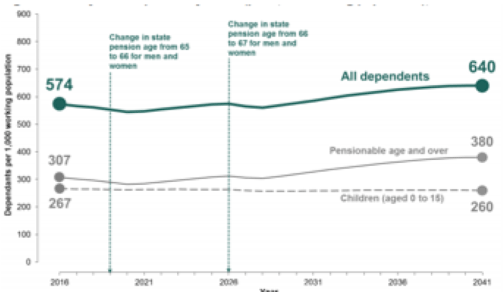
Source: Mid-year population estimates and National Population Projections (2016-based), National Records of Scotland, Office for National Statistics
Migration
2.17. In 2015-16, net migration to Scotland was positive at 31,700, with 22,900 from overseas and 8,800 from the rest of the UK[10].
- Net migration from overseas is projected to decrease from the latest estimate of 22,900 in 2015-16 to 7,000 in 2040-41.
- Net migration from the rest of the UK is also projected to fall, but by far less from 8,800 in 2015-16 to 7,600 in 2040-41.
2.18. In-migration to Scotland from the rest of the UK is projected to increase slightly from the latest estimate of 46,300 in 2015-16 to 47,100 in 2040-41, with out-migration from Scotland to the rest of the UK is also projected to increase from 37,500 to 39,500 in the same period12.
2.19. In-migration to Scotland from overseas, however, is projected to decrease substantially from 40,400 in 2015-16 to 30,500 in 2040-41, while out-migration to overseas is projected to increase from 17,500 to 23,500 over the same period12.
Births and deaths
2.20. The projected figures show that the number of deaths is projected to be higher than the number of births in every year from 2016-17 to 2040-41. From 2017-18 to 2023-24, the number of births and deaths are projected to be similar, with less than 1,000 more deaths than births each year during this period12.
2.21. Beyond 2024, the number of deaths each year is projected to increase with births remaining at a broadly similar level. This means that by the year 2038-39 there are projected to be 10,000 more deaths than births each year in Scotland12 (figure 4).
Figure 2.6: Births and deaths, actual and projected, Scotland, 2001-02 to 2040-41
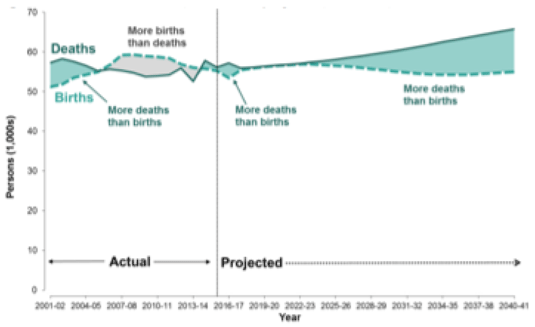
Source: Mid-year population estimates and National Population Projections (2016-based), National Records of Scotland, Office for National Statistics
Life expectancy
2.22. Life expectancy for females is projected to increase to 84.5 years over the next 25 years from the most recent estimate of 81.2 years for those born around 2015 (an increase of 3.4 years). Males are projected to experience a larger increase in life expectancy of 4.6 years, from 77.1 years for those born around 2015 to 81.7 years in 2041[11].
Assumptions underlying different scenarios
2.23. Figure 2.6 shows the projected population under the different variant assumptions. The high population variant projects an increase in the population to 6.12 million in 2041 (13% increase) from the latest estimate of 5.40 million in 2016. The natural change only variant projects the lowest population in 2041 of 5.17 million, a 4% decrease13.
Figure 2.7: Actual and projected total population of Scotland, under the 2016-based principal and selected variant projections, 2006-2041
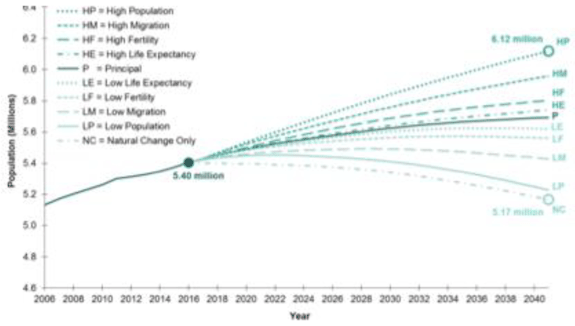
Source: Mid-year population estimates and National Population Projections (2016-based), National Records of Scotland, Office for National Statistics
2.24. The assumptions for the principal and each of the variant projections are shown in Figure 2.7. The assumptions for the long-term total fertility rate vary from a low of 1.45 to a high of 1.75. For life expectancy the differing mortality assumptions result in a range of 79.8 years to 82.9 years for male life expectancy in 2041 and 82.8 22 years to 85.6 years for females. The low and high assumptions for net migration from overseas range from -1,500 to 15,500 in 2041[12].
Figure 2.8: Assumptions for the 2016-based principal and variant projections for Scotland
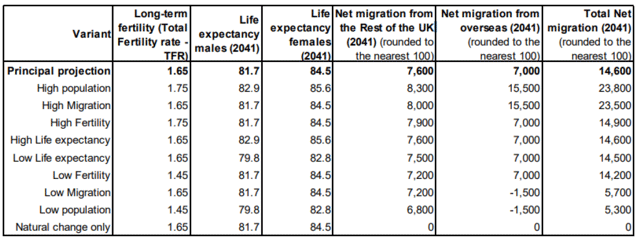
Source: National Records of Scotland (2017) Population Projections for Scottish Areas (2016-based).
Contact
Email: Gregor.Auld@gov.scot
There is a problem
Thanks for your feedback